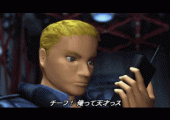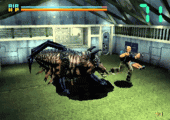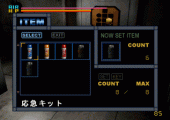Genre: Survival Horror Developer: AM7 Publisher: Sega Ent. Players: 1 Released: 1998
Survival horror games are quite commonplace now, with juggernauts like the Resident Evil series making the rounds on all platforms. We can play them on our TVs, PCs, and even on the go. To think then, that there was a time when such titles were few and far between, and often confined to a single platform. Back in the mid-’90s, Saturn owners sat in a corner and wondered where their monster-filled nightmare game was. The 3D0 and PC had Alone in the Dark, and the PlayStation had Resident Evil. Sega usually had something to fill the gaps in most genres, but it didn’t seem like the publisher was in any hurry to compete here.
Capcom came through with a great port of Resident Evil in 1997, which seems to have lit a fire under Sega or at least prompted someone at the company to sigh an exhausted “oh, all right…” A year later, the company released Deep Fear – but only in Japan and Europe. American gamers were left to import, but thankfully, that wasn’t much of an issue. I think the developers were aware that the Saturn was at its end in the West, which could explain why the Japanese version of Deep Fear is almost entirely playable in English. Of course, the PAL version is entirely localized, but one still had to deal with the whole PAL/NTSC speed issue.
Considering how late in came in the Saturn’s life and the development team behind it, Deep Fear should have been the defining survival horror title of the 32-bit era. Sega had all two years to build on Resident Evil’s fame, and development was handled by AM7, which included gurus Rieko Kodama and Noriyoshi Ohba. The monster were designed by manga artist Yasushi Nirasawa. With so much going for it, Deep Fear should have been the game to beat Capcom’s monster hit, right?
Well, not quite. In all honesty, there isn’t anything really bad about Deep Fear (except the voice acting, but more on that in a minute). It was solid and fun, and it even added some unique gameplay mechanics to the established formula. Sadly, these didn’t really compensate for what the game didn’t do, which was failing to really establish itself as a true successor to the Resident Evil style or even show the possible innovation that AM7 was clearly capable of producing. Chalk it up to Deep Fear getting a bit lost in shuffle as the Saturn wound down in the West (it was Sega’s last Saturn title in Europe) or in the ton of games on Sega of Japan’s plate. Who knows? The reality is that Deep Fear stood out as more as an example of lost potential than it did on its own merits.
As I said though, there isn’t anything inherently wrong with the game. Deep Fear’s plot joined the ’90s trope of underwater bases beset by murderous monsters. Like The Abyss and Leviathan, Sega’s game had its main characters experiencing turmoil on the ocean floor. Players took the role of an ex-navy SEAL, John Mayor, who was trapped in a deep sea research facility called the “Big Table.” Events led to a breakout of nasty mutants that killed most of the crew, and Mayor had to use the items and resources available to get himself and his friends safely to the surface.
In design and execution, Deep Fear mostly adhered to the standard survival horror script. Players found items and weapons, performed tasks and solved puzzles and used key cards to open new areas and prevent others from being destroyed, and fought monsters along the way. Even the control scheme was typical, with the same “tank” controls so many people have come to hate over the years (I found that the Saturn’s analog 3D controller made playing much easier). The item and map screens were similar to Resident Evil, and anyone who played that game could dive right in without much of a learning curve.
Using weapons was easy, and Deep Fear had multiple armament stations scattered around the Big Table base. Unlike Resident Evil, where ammunition is deliberately scarce to force players to make strategic decisions and know when discretion is the better part of valor, Deep Fear let them go full-on John Wick with their guns. The starting hand pistol held a whopping 85 bullets! The weapons stations replenished all arms completely an unlimited amount of times, making the “survival” part of the game a bit less meaningful. Some bosses could take a beating to compensate but heading into fight fully stocked meant players had little chance of failure.
There were some cool innovative elements that Deep Fear added to the mix that are worth mentioning. Most notable was the fact that it was the first game with fixed camera angles that let players run or draw their gun and fire, all in real time. It made complete use of the Saturn’s six-button controller, and players had the freedom to access the map and access health items without having to pause and enter the menu screen. No other survival horror title of the era had these features, and the genre took years to catch up. Adding to these distinct qualities was the need to replenish Big Table’s oxygen supply. The infectious creatures plaguing the installation did not like high oxygen environments, so along with providing fresh air for Mayor and the others to breathe, activating the oxygen stations provided some reprieve from danger. The stations were also where players could save their progress. The low-oxygen rooms appeared on the map in red, and if Mayor was too far from a station, he could use oxygen grenades to increase the air level in a room.
Another area where Deep Fear brought its own flavor was in its presentation. The game was chock full of cut scenes, some quite long, and these featured some brilliant music composed by Kenji Kawai, the man behind the scores for anime hits like Ghost in the Shell and Mobile Police Patlabor. It really was a great thing to watch these scenes with the lights off and with the Saturn connected to a stereo system. Deep Fear’s gameplay had almost no music and relied on sound effects to create its element, never really managing to create the required level of tension. I wish Kawai’s soundtrack had found its way into more of the game, as it did an excellent job at setting the ambiance.
The in-game graphics had the same issues many 32-bit games suffered. The pre-rendered backgrounds were clear and detailed, but some of the character models were… less impressive. For instance, the monsters had some great animation and style to them, but the human models were blocky and often hard to define. They also moved very stiffly. This issue, while annoying during play, only slightly hurt them as characters, as some of Mayor’s companions had great personalities that made one want to save them more than the forgettable companions in other survival horror games. The English language voice acting really makes it unfortunate that Deep Fear never got a stateside release. U.S. gamers would have really appreciated these details.
About that voice acting… More than the spotty gameplay, what really killed the survival horror vibe for me was just how atrocious it was. It’s so bad in Deep Fear that it makes Resident’s Evil “Jill sandwich” lines sound like Victorian prose. Seriously, the actors didn’t just phone in their lines. They got drunk, smoked pot, went three days without sleep and then came in to record the dialogue. It’s not that the lines themselves were bad – they were – but the voice actors didn’t even try to sound convincing. Mayor’s partner, Mookie Carver, was particularly cringe-worthy. Without any music to create a sense of fear and tension, the laughable dialogue moved Deep Fear far away from the “horror” aspect it was supposed to push.
Deep Fear puts more emphasis on action than it does on horror, and thankfully, it does that quite well. The undersea station is large and looks good, and the enemy designs are terrific. The bosses are especially impressive and will give players several hours of entertaining exploration and combat. If Sega were to remaster it and build on what Capcom has improved in its own brand, I feel that Deep Fear could stand as a quality title and even launch a franchise. The Saturn game isn’t as impressive as its competition, but it’s a fun way to spend an afternoon. The PAL version is entirely in English, but there’s really only one puzzle in the Japanese release that requires some help. Either one is worth tracking down. Sega had a solid foundation for an amazing survival horror title, and while Deep Fear may not be the top of the line, its flaws aren’t enough to sink it.
SCORE: 7 out of 10










Recent Comments